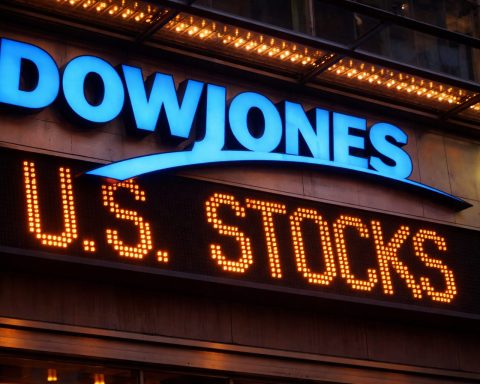U.S. stock futures were under pressure again on Friday, November 14, 2025, as investors contended with an AI-driven tech sell-off, fading hopes for a December Federal Reserve rate cut and a messy U.S. data calendar still disrupted by the recent government shutdown.
By around 7:25 a.m. ET, Dow futures were down about 223 points, S&P 500 futures were lower by roughly 54 points and Nasdaq 100 futures were off by about 317 points, according to RTT News data syndicated via Finanzen.ch. [1] A little over an hour later, S&P 500 futures were down about 1.1%, Dow futures about 0.7% and Nasdaq futures roughly 1.5%, signaling another risk-off open for Wall Street. [2]
At the same time, the Nasdaq 100 pre-market indicator was showing a drop of more than 400 points to around 24,567, underscoring renewed pressure on the tech-heavy gauge after Thursday’s rout. [3]
U.S. stock futures today: selling continues after AI-led tech rout
Friday’s futures weakness follows one of Wall Street’s worst sessions since April. On Thursday:
- The S&P 500 fell 1.7% to 6,737.49
- The Dow Jones Industrial Average lost 1.7% to 47,457.22
- The Nasdaq Composite dropped 2.3% to 22,870.36 [4]
The trigger was a sharp pullback in high-flying artificial intelligence names such as Nvidia, Super Micro Computer, Palantir and Broadcom, as traders questioned whether AI-linked valuations have simply run too far, too fast. [5]
Pre-market trading on Friday showed those worries lingering:
- The Nasdaq 100 Pre-Market Indicator was down 426 points, while AI and quantum-computing names like Nvidia, IonQ and D-Wave Quantum were among the most active movers before the opening bell. [6]
- Leveraged bearish ETFs such as ProShares UltraPro Short QQQ (SQQQ) were also heavily traded, indicating traders were positioning for more volatility in big tech. [7]
Despite the gloomy futures picture at the open, intraday trading turned more mixed. By about midday, the S&P 500 and Nasdaq Composite had clawed back into positive territory, up roughly 0.4% and 0.7% respectively, while the Dowremained modestly lower as financials lagged. [8] Tech shares bounced as investors once again tried to “buy the dip” in AI leaders like Nvidia after early losses. [9]
That tug-of-war between fear of an AI bubble and the instinct to buy any pullback in the year’s biggest winners is shaping the tone of stock futures throughout the day.
Overnight: Asia and Europe extend the sell-off
Global markets set the stage for Friday’s weak U.S. stock futures.
Asia: tech-heavy indexes hit hardest
Asian markets broadly tracked Thursday’s U.S. tumble:
- South Korea’s Kospi led regional declines, sinking about 3.2%, with Samsung Electronics and SK Hynix down more than 4% and 6% respectively. [10]
- Japan’s Nikkei 225 fell around 1.7–1.8% to just above 50,000, reversing the prior day’s gains amid steep losses in SoftBank and other AI-related holdings. [11]
- Hong Kong’s Hang Seng dropped roughly 1.3–1.9%, while Shanghai’s main index lost between 0.2% and nearly 1%, depending on which benchmark you track. [12]
- Australia’s S&P/ASX 200 fell about 1.4%, hitting a new four‑month low as hopes for near‑term rate cuts from the Reserve Bank of Australia faded. [13]
Weak Chinese data added another layer of concern. New figures out of Beijing showed:
- Industrial output up just 4.9% year-on-year in October (vs. 6.5% in September)
- Retail sales up 2.9%, also the softest pace in over a year
- Fixed-asset investment down 1.7% in the first ten months of 2025, signaling deeper investment and property-sector stresses [14]
These numbers underscored that China’s economy is being squeezed by both sluggish domestic demand and ongoing trade-war pressures, amplifying investor caution in Asian equities and feeding into weaker U.S. futures.
Europe: rate-cut hopes fade, government shutdown fallout lingers
European markets followed Asia lower and finished the session firmly in the red:
- The Stoxx 600 fell about 1.0%
- The FTSE 100 in London lost 1.1%
- Germany’s DAX dropped 0.7%, and France’s CAC 40 slipped 0.8% [15]
Investors in Europe are wrestling with two big themes:
- Fading Fed rate-cut expectations:
A more hawkish tone from several Fed officials has sharply reduced the odds of another U.S. rate cut in December, pressuring global equities and pushing bond yields higher. [16] - Data disruptions and shutdown aftershocks in the U.S.:
Although the record U.S. government shutdown has technically ended, markets are still operating in what Reuters described as a “data fog,” with key inflation and labor reports delayed or potentially never released. [17]
The combination of softer Chinese data, AI valuation worries and less clarity on U.S. macro trends left European investors defensive — a stance mirrored in U.S. stock futures ahead of the open.
Fed rate-cut odds: from near certainty to coin flip
Stock futures today are being driven as much by expectations about the Federal Reserve as by earnings or economic fundamentals.
At the start of the autumn, traders were almost certain the Fed would deliver a third rate cut in December after easing twice earlier in the year. Over the past week, that view has shifted dramatically:
- The CME FedWatch tool now shows roughly a 50% chance of a quarter‑point cut in December.
- That’s down from around two‑thirds just a week ago and even higher odds earlier this autumn, according to Reuters and RTTNews analyses. [18]
Hawkish comments from multiple Fed officials, who have highlighted persistent inflation risks and a still‑reasonably stable labor market, are at the heart of this repricing. [19]
Higher expected policy rates weigh most heavily on:
- High‑growth and AI-focused tech stocks
- Rate‑sensitive areas like small caps, unprofitable tech and speculative assets including crypto [20]
That helps explain why both tech futures and cryptocurrencies have been hit so hard over the past 24 hours.
Data blackout: key U.S. reports still missing from the tape
Normally, a day like today would be dominated by fresh macro data. On the calendar for Friday, November 14, 2025, were:
- Producer Price Index (PPI) – October (8:30 a.m. ET)
- Advance retail sales – October (8:30 a.m. ET)
- Business inventories – September (10:00 a.m. ET)
- EIA weekly natural gas storage report (10:30 a.m. ET)
- Baker Hughes weekly rig count (1:00 p.m. ET) [21]
But because of the recent federal government shutdown, the American Chemistry Council notes that CPI, real wage data, PPI, retail sales and business inventories are “unavailable” this week, forcing analysts and investors to lean on private-sector indicators instead. [22]
A detailed preview from EBC Financial Group highlighted market anxiety over whether the October PPI data would even be released on schedule, pointing out that a delay or incomplete dataset could itself spark a risk‑off move — independently of the actual inflation number. [23]
This unusual data risk is now a core part of the story in stock futures:
- If key reports remain missing or are heavily distorted, traders have less confidence in their models.
- That uncertainty tends to push investors toward cash, Treasuries and the U.S. dollar, and away from equities and high‑beta trades, pressuring futures. [24]
Crypto, gold and other risk gauges echo the futures story
Market stress is not confined to stock futures.
An RTTNews review of digital assets notes that cryptocurrencies plunged more than 6% in market value over the past 24 hours, with Bitcoin briefly dipping toward the mid‑$90,000s and Ethereum slipping toward $3,100. The report ties the slide directly to fading Fed rate‑cut hopes and hawkish commentary from policymakers. [25]
At the same time:
- Gold prices have reversed sharply lower after a strong run, as higher real yields and a firmer dollar sap demand for the metal, even while macro uncertainty remains elevated. [26]
- Treasury yields have ticked higher again, with the 10‑year near 4.1% as investors reprice the path of Fed policy. [27]
These cross‑asset signals are consistent with what stock index futures are showing: investors are increasingly cautious, not just about earnings, but about the entire policy and macro backdrop going into year‑end.
Sectors and stocks to watch in today’s session
Based on pre-market flows and overnight headlines, here’s where attention is likely to focus as the cash market trades around today’s futures signals:
1. AI and semiconductor names
- Nvidia, AMD, IonQ, BigBear.ai, D‑Wave Quantum and other AI‑linked stocks are heavily traded in pre‑market, with a tilt toward selling as investors reassess lofty earnings expectations and capex plans. [28]
- Nvidia’s earnings next week are seen as a critical test of whether the AI trade still has legs or has entered bubble territory. [29]
2. Financials and rate‑sensitive plays
- Banks and credit‑sensitive financials have lagged as investors rethink how long rates might stay elevated and what that means for loan demand and credit quality. [30]
- Small caps and other domestic cyclicals are also under pressure, a sign that markets are increasingly worried about growth rather than just inflation.
3. European and U.K.-exposed names
- With the FTSE 100, DAX and CAC 40 all lower by about 0.7–1.1% on the day, and U.K. bond yields jumping on worries about a potential budget U‑turn, U.S.-listed multinationals with heavy European exposure may see added volatility. [31]
4. China-related stocks
- Weak Chinese industrial output and retail sales, plus ongoing property‑sector problems, are weighing on sentiment around commodity producers, global manufacturers and consumer brands dependent on Chinese demand. [32]
What today’s stock futures signal for investors
Put together, today’s stock futures are flagging a market that is:
- Still digesting Thursday’s AI-led shock
- Grappling with a less dovish Fed and lower odds of a December rate cut
- Navigating a rare U.S. data blackout after the longest government shutdown in history
- Reacting to weaker Chinese growth and renewed pressure on global risk assets
For short‑term traders, that means elevated volatility and fast intraday reversals — exactly what we’ve seen with futures plunging pre‑market and then spot indexes clawing back some losses as dip‑buyers step in.
For longer‑term investors, today’s moves are less about predicting a single day’s close and more about recognizing the big themes:
- The AI trade is moving from unquestioned momentum story to a more fragile, valuation‑sensitive phase.
- The Fed narrative has shifted from “cuts are coming” to “cuts are now a coin flip.”
- The economic picture is complicated by data gaps, especially around U.S. inflation and consumption.
None of this is a reason to panic, but it is a reminder that stock futures — particularly on volatile days like Friday, November 14, 2025 — are reflecting real uncertainty around both growth and policy.
Note: This article is for informational purposes only and does not constitute financial or investment advice. Consider your own objectives and consult a qualified professional before making trading or investment decisions.
References
1. www.finanzen.ch, 2. www.cbsnews.com, 3. www.nasdaq.com, 4. www.finanzen.ch, 5. www.wral.com, 6. www.nasdaq.com, 7. www.nasdaq.com, 8. www.reuters.com, 9. www.reuters.com, 10. www.wral.com, 11. www.wral.com, 12. www.wral.com, 13. www.wral.com, 14. www.reuters.com, 15. www.rttnews.com, 16. www.reuters.com, 17. www.reuters.com, 18. www.reuters.com, 19. www.reuters.com, 20. www.rttnews.com, 21. www.finanzen.ch, 22. www.americanchemistry.com, 23. www.ebc.com, 24. www.reuters.com, 25. www.rttnews.com, 26. www.rttnews.com, 27. www.reuters.com, 28. www.nasdaq.com, 29. www.reuters.com, 30. www.reuters.com, 31. www.rttnews.com, 32. www.reuters.com










